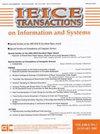Large-Scale Gaussian Process Regression Based on Random Fourier Features and Local Approximation with Tsallis Entropy
IF 0.6
4区 计算机科学
Q4 COMPUTER SCIENCE, INFORMATION SYSTEMS
IEICE Transactions on Information and Systems
Pub Date : 2023-10-01
DOI:10.1587/transinf.2023edl8016
引用次数: 0
Abstract
With the emergence of a large quantity of data in science and industry, it is urgent to improve the prediction accuracy and reduce the high complexity of Gaussian process regression (GPR). However, the traditional global approximation and local approximation have corresponding shortcomings, such as global approximation tends to ignore local features, and local approximation has the problem of over-fitting. In order to solve these problems, a large-scale Gaussian process regression algorithm (RFFLT) combining random Fourier features (RFF) and local approximation is proposed. 1) In order to speed up the training time, we use the random Fourier feature map input data mapped to the random low-dimensional feature space for processing. The main innovation of the algorithm is to design features by using existing fast linear processing methods, so that the inner product of the transformed data is approximately equal to the inner product in the feature space of the shift invariant kernel specified by the user. 2) The generalized robust Bayesian committee machine (GRBCM) based on Tsallis mutual information method is used in local approximation, which enhances the flexibility of the model and generates a sparse representation of the expert weight distribution compared with previous work. The algorithm RFFLT was tested on six real data sets, which greatly shortened the time of regression prediction and improved the prediction accuracy.基于随机傅立叶特征和Tsallis熵局部逼近的大规模高斯过程回归
随着科学和工业中大量数据的出现,提高高斯过程回归(Gaussian process regression, GPR)的预测精度和降低其高复杂性已成为迫切需要解决的问题。然而,传统的全局近似和局部近似都存在相应的缺点,如全局近似容易忽略局部特征,局部近似存在过拟合问题。为了解决这些问题,提出了一种结合随机傅立叶特征(RFF)和局部近似的大规模高斯过程回归算法。1)为了加快训练时间,我们使用随机傅立叶特征映射将输入数据映射到随机低维特征空间进行处理。该算法的主要创新之处在于利用现有的快速线性处理方法设计特征,使变换后的数据的内积近似等于用户指定的移位不变核特征空间内的内积。2)采用基于Tsallis互信息方法的广义鲁棒贝叶斯委员会机(GRBCM)进行局部逼近,增强了模型的灵活性,与前人相比,生成了专家权重分布的稀疏表示。RFFLT算法在6个真实数据集上进行了测试,大大缩短了回归预测时间,提高了预测精度。
本文章由计算机程序翻译,如有差异,请以英文原文为准。
求助全文
约1分钟内获得全文
求助全文
来源期刊

IEICE Transactions on Information and Systems
工程技术-计算机:软件工程
CiteScore
1.80
自引率
0.00%
发文量
238
审稿时长
5.0 months
期刊介绍:
Published by The Institute of Electronics, Information and Communication Engineers
Subject Area:
Mathematics
Physics
Biology, Life Sciences and Basic Medicine
General Medicine, Social Medicine, and Nursing Sciences
Clinical Medicine
Engineering in General
Nanosciences and Materials Sciences
Mechanical Engineering
Electrical and Electronic Engineering
Information Sciences
Economics, Business & Management
Psychology, Education.
 求助内容:
求助内容: 应助结果提醒方式:
应助结果提醒方式:


